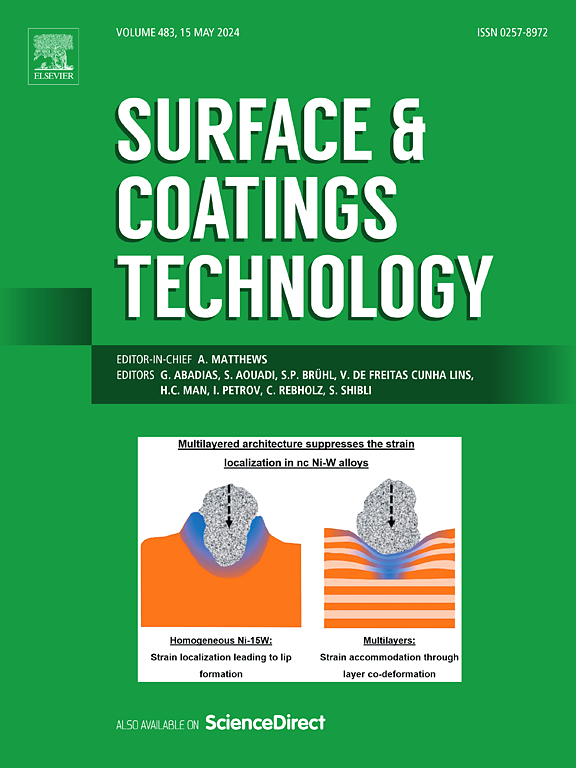聚乙烯和聚丙烯在Ti3C2Tx MXenes上吸附的DFT研究
IF 5.3
2区 材料科学
Q1 MATERIALS SCIENCE, COATINGS & FILMS
引用次数: 0
摘要
聚烯烃是一类广泛应用于工业的聚合物。纳米填料的掺入是改善聚烯烃性能以扩大其应用的一种方法。MXenes是一种新的、有前途的纳米填料,具有生产性能增强的聚烯烃基纳米复合材料的潜力,它由二维过渡金属碳化物和/或氮化物组成。在这项工作中,进行了一系列全面的密度泛函理论(DFT)计算,以研究两种最广泛使用的聚烯烃,聚乙烯(PE)和聚丙烯(PP)与Ti3C2Tx MXenes (Tx = O2, F2, S2, Cl2和(OH)2)的相互作用。模型体系由吸附在MXene表面不同构型的PE或PP单链组成。聚合物-MXene结合能(MXene末端的函数)表明,两种聚合物对o2端MXene的粘附更强,而对Ti3C2(OH)2的吸附最弱。在所有情况下,相对较大的聚合物/MXene分离(范围从2.2到几乎3 Å)意味着弱相互作用(与氢键组分的范德华作用)占主导地位。PE/MXene的结合能远高于PP/MXene的结合能,表明PE/MXene复合材料具有更强的界面附着力。与聚合物/MXene相互作用的整体弱性质一致,电子结构分析表明,无论表面终止还是吸附聚合物,MXene的金属性质都保持不变。本文章由计算机程序翻译,如有差异,请以英文原文为准。
Polyethylene and polypropylene adsorption on Ti3C2Tx MXenes: a DFT study
Polyolefins form a large class of polymers extensively used in industry. An approach to improve the properties of polyolefins to expand their applications is the incorporation of nanofillers. A new and promising family of nanofillers with potential to produce polyolefin-based nanocomposites with enhanced properties are MXenes, which comprise 2D transition-metal carbides and/or nitrides. In this work, a comprehensive series of Density Functional Theory (DFT) calculations was conducted to examine the interaction of the two most widely used polyolefins, polyethylene (PE) and polypropylene (PP), with Ti3C2Tx MXenes (Tx = O2, F2, S2, Cl2, and (OH)2). The model systems consisted of single chains of either PE or PP adsorbed on the MXene surface in different configurations. The polymer-MXene binding energies, calculated as a function of MXene terminations, revealed that both polymers adhered more strongly to the O2-terminated MXene, while adsorption on Ti3C2(OH)2 was the weakest. In all cases, the relatively large polymer/MXene separation (ranging from 2.2 to almost 3 Å) implies that weak interactions (van der Waals with a hydrogen bonding component) predominate. It is also observed that PE/MXene binding energies were much higher than those of PP/MXene, thus indicating stronger interfacial adhesion is expected in PE/MXene composites. Consistent with the overall weak nature of the polymer/MXene interaction, electronic structure analysis shows that the metallic character of MXene was preserved regardless of surface termination or adsorbed polymer.
求助全文
通过发布文献求助,成功后即可免费获取论文全文。
去求助
来源期刊

Surface & Coatings Technology
工程技术-材料科学:膜
CiteScore
10.00
自引率
11.10%
发文量
921
审稿时长
19 days
期刊介绍:
Surface and Coatings Technology is an international archival journal publishing scientific papers on significant developments in surface and interface engineering to modify and improve the surface properties of materials for protection in demanding contact conditions or aggressive environments, or for enhanced functional performance. Contributions range from original scientific articles concerned with fundamental and applied aspects of research or direct applications of metallic, inorganic, organic and composite coatings, to invited reviews of current technology in specific areas. Papers submitted to this journal are expected to be in line with the following aspects in processes, and properties/performance:
A. Processes: Physical and chemical vapour deposition techniques, thermal and plasma spraying, surface modification by directed energy techniques such as ion, electron and laser beams, thermo-chemical treatment, wet chemical and electrochemical processes such as plating, sol-gel coating, anodization, plasma electrolytic oxidation, etc., but excluding painting.
B. Properties/performance: friction performance, wear resistance (e.g., abrasion, erosion, fretting, etc), corrosion and oxidation resistance, thermal protection, diffusion resistance, hydrophilicity/hydrophobicity, and properties relevant to smart materials behaviour and enhanced multifunctional performance for environmental, energy and medical applications, but excluding device aspects.
 求助内容:
求助内容: 应助结果提醒方式:
应助结果提醒方式:


